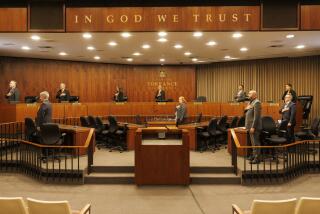Local Elections : Tax Measure to Add Police Draws Scant Notice in Hawthorne
At this week’s Hawthorne City Council meeting, the last before the Nov. 8 election, no mention was made by the council or public of a Hawthorne ballot measure seeking a tax increase to pay for increased police protection.
Proposition V, which would increase the city’s utility-users’ tax to 6%, from 3 1/2%, has generated a decidedly low-key campaign, said local political observers. It contrasts sharply, they noted, with the heated public debate that took place last November on a paramedic-funding tax measure, which failed to get the two-thirds majority needed to pass.
The campaign on Proposition V has been “really quiet,” Councilman Steve Andersen said in an interview Tuesday. “There have been so many tax measures in Hawthorne in my day that have drawn so much interest, but on this one I haven’t heard a word.”
Proposition V, which needs a two-thirds majority to win, would raise an estimated $2 million a year to hire 19 sworn police officers, bringing the department total to 104.
Pros and Cons
Supporters contend that the city needs more police to fight crime, while opponents argue that the city should eliminate “unnecessary” expenditures before asking residents to pay higher taxes.
The added tax would cost an average household an additional $3.75 a month, increasing the monthly utility tax to $9 from $5.25, officials estimated. The tax increase would be reflected on r1702062436electric, telephone and cable television bills.
Police Chief Kenneth R. Stonebraker and Capt. Stephen Port, who have been lobbying in favor of the measure at numerous community meetings in recent weeks, said that the department needs 19 more officers to help cope with increases in the city’s population and in gang- and drug-related crime. Community response to the plan has been “very positive,” Port said.
Supporters say the Hawthorne Police Department is understaffed, with 1.27 police officers for each 1,000 residents, compared to an average of 1.75 per 1,000 for surrounding South Bay cities. The hiring of 19 officers would increase Hawthorne’s ratio to 1.55 per 1,000, according to Councilman Chuck Bookhammer, who wrote the ballot argument in favor of Proposition V. The council unanimously supports the measure, which it placed on the ballot to let voters decide on the tax for police protection, he said.
Audit Suggested
Opponents of Proposition V include Raymon Sulser, a former city Planning Commission chairman who wrote the ballot argument against the measure. He said that before the city imposes additional taxes it should “have an efficiency expert do an audit of the council’s spending, weed out unnecessary spending (and) cut non-productive personnel.”
In an interview, Sulser gave a number of examples of what he regards as excessive spending, including the city’s recent $56,000 purchase of five used cars for top city officials, about $40,000 for Fire Department training in Northern California, and an unspecified amount for city management staff lunches. “The city manager makes $116,000 a year,” Sulser told a reporter. “You would think he could pay for his own lunch every day.”
Spokesman Tom Quintana said Thursday that city policies allow the city manager to hold staff and council briefings during luncheons paid by the city.
City Manager R. Kenneth Jue was out of town on vacation this week and unavailable for comment. According to city personnel officials, Jue makes $84,192 a year, plus medical benefits costing about $4,800 a year. The total compensation is “nowhere near” the $116,000 Sulser claimed, they said.
1984 Utility Tax
Sulser also said that when the city’s current 3 1/2% utility tax was enacted by the City Council in 1984, the council said it was to be a temporary tax to solve a budget crisis. “They are still collecting approximately $3 million a year on this tax,” he said on the b1634495599add another $2 million a year on their taxes. . . . You can believe that whatever is approved, they will spend.”
Although the increased utility tax would cost businesses more because they are likely to have larger utility bills than would residences, the city’s largest employer, Northrop Corp., has taken no public position on Proposition V, according to a company spokesman.
The Hawthorne Chamber of Commerce would have preferred a “more modest” tax, but will not oppose the measure because the business community acknowledges the need for more police, said chamber manager Lila Morgan.
Survey of Cities
A survey of other cities showed that eight--El Segundo, Gardena, Hermosa Beach, Inglewood, Palos Verdes Estates, Redondo Beach, Torrance and Los Angeles have utility taxes ranging from 2% (El Segundo) to 12 1/2% (Los Angeles). Rancho Palos Verdes will discontinue its 5% utility tax Nov. 15 because a majority of the city’s voters in June opposed a measure that sought to continue the tax.
Seven area municipalities do not have a utility tax: Carson, Lawndale, Lomita, Manhattan Beach, Rolling Hills, Rolling Hills Estates and Los Angeles County.
Inglewood, which has a 10% utility tax, has placed an advisory measure--Proposition BB--on the Nov. 8 ballot asking whether voters would support the creation of a parcel tax that would provide $1.4 million to hire 20 police officers. The measure is non-binding and does not in itself authorize the tax. The measure needs a simple majority to pass.
By contrast, Hawthorne’s Proposition V would enact a special-use tax and requires a two-thirds majority to pass.
Last November, a ballot measure seeking tax money for paramedic services won 48.4% of the vote but failed to get a two-thirds majority. “A two-thirds vote is very difficult to get,” Mayor Betty J. Ainsworth said at the time.
Officials acknowledge that even though police protection is a popular issue in Hawthorne, it may not pass.
The city has 25,260 registered voters. Last November, only 3,359 (about 13%) cast votes on the paramedic funding measure.
More to Read
Sign up for Essential California
The most important California stories and recommendations in your inbox every morning.
You may occasionally receive promotional content from the Los Angeles Times.










